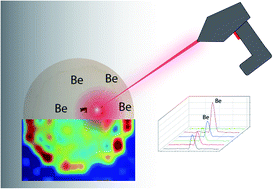Investigation of handheld laser induced breakdown spectroscopy (HH LIBS) for the analysis of beryllium on swipe surfaces
Abstract
Handheld laser induced breakdown spectroscopy (HH LIBS) was explored for its feasibility to perform rapid, semi-quantitative analysis of beryllium (Be) on fibrous swipe materials which could prove to be impactful for industrial hygiene (IH) based applications. Here, the HH LIBS methodology was compared to established methods including inductively coupled plasma-optical emission spectroscopy and fluorescence spectroscopy to examine its ability to accurately determine Be concentrations on swipe samples. It was determined that, while not as precise as ICP-OES and fluorescence spectroscopy, HH LIBS was able to quantify Be on solid substrates with values of 0.63 and 4.98 μg Be for swipes that contained 0.5 and 5.0 μg Be. In addition to quantification, HH LIBS was explored for its ability to chemically map the Be on the swipe material. Be can be detected directly from the swipe surface and subsequently, spatial analysis of the desired analyte can be performed by rastering a desired pattern that can be translated into a chemical map. The HH LIBS methodology could prove to be a vital analytical technique for applications in which rapid chemical analysis must be performed in the field to determine the presence of beryllium.



 Please wait while we load your content...
Please wait while we load your content...